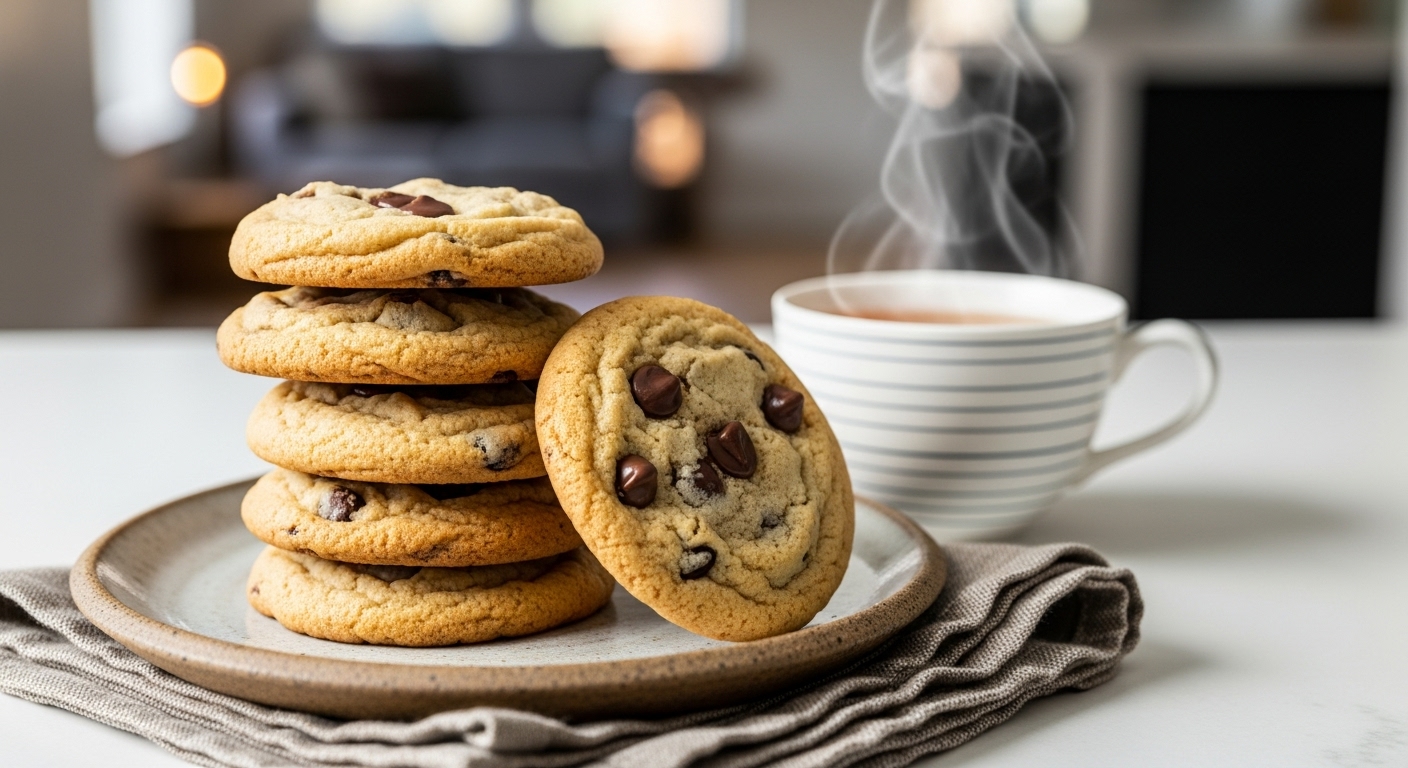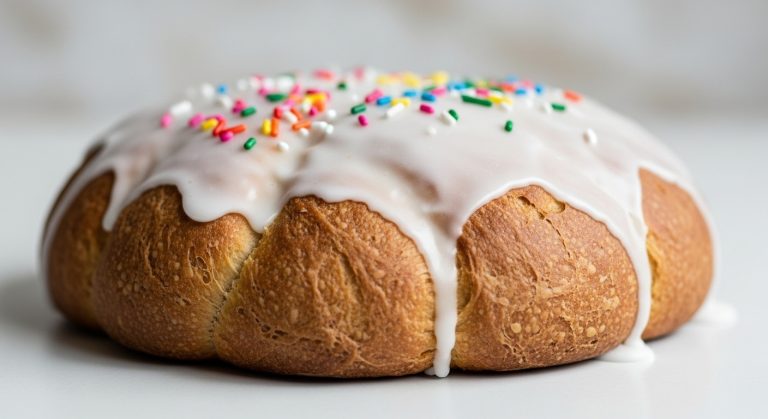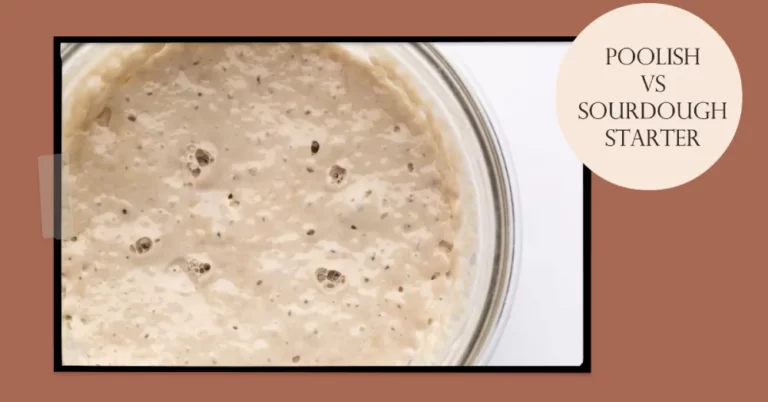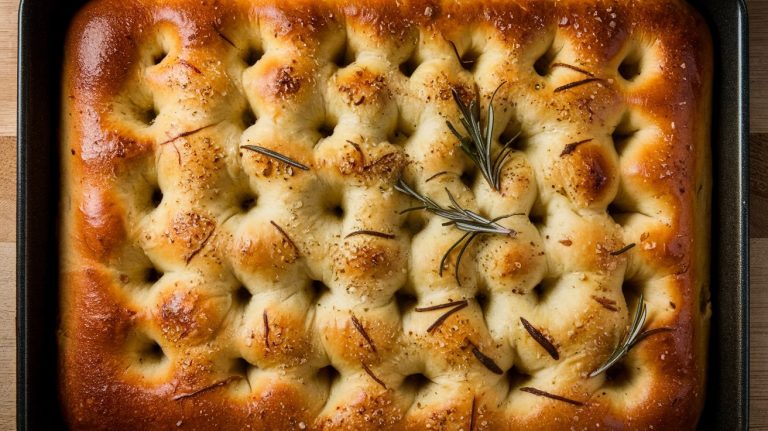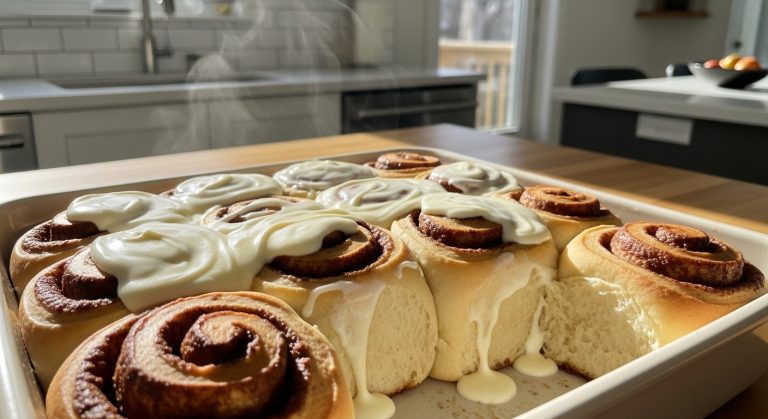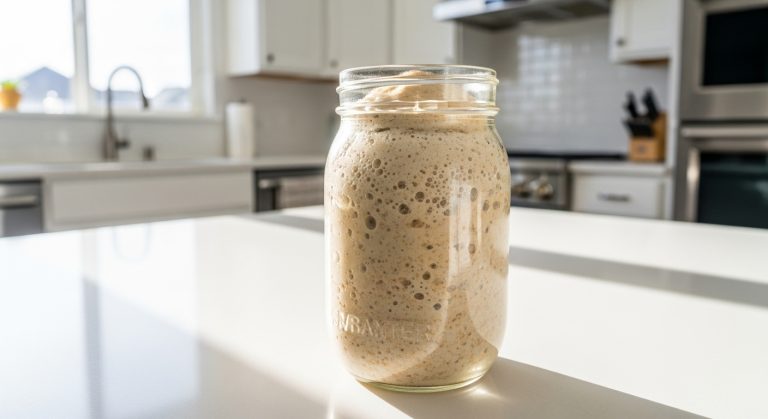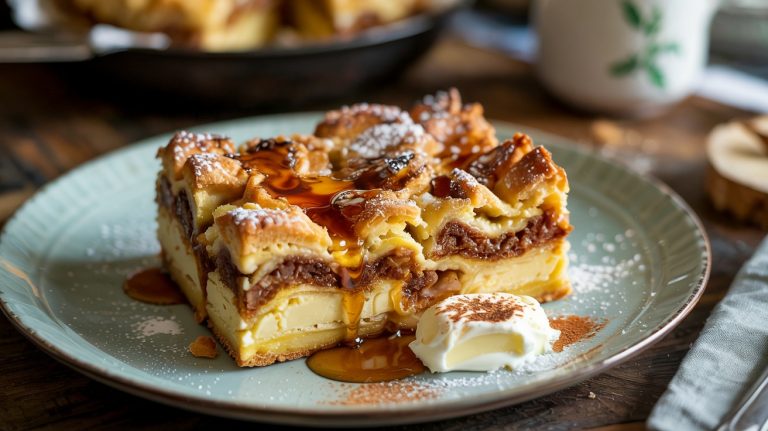Perfect Sourdough Discard Cookie Recipe with Browned Butter
You’ll turn tangy, 100%‑hydration sourdough discard into chewy, browned‑butter cookies studded with molten chocolate and flaky sea salt. Measure by weight, warm and whisk the discard with browned butter, sugars, an egg, and vanilla until glossy, then fold into a precisely weighed flour mix with baking soda, a touch of baking powder, and spices.
Chill scooped dough for even edges, bake until golden, rest briefly, and enjoy; keep going to learn tips for texture, mix‑ins, and storage.
Key Takeaways
- Weigh 100% hydration sourdough discard and adjust by weight for consistent cookie hydration and texture.
- Use 95–340 g all-purpose flour (optionally blend bread flour) and measure dry ingredients by weight.
- Cream melted or browned butter with 100–210 g sugar, eggs, 1–2 tsp vanilla, and 184–226 g butter total for flavor and structure.
- Fold in 100 g–340 g mix-ins (chocolate, nuts, seeds), chill dough ≥30 minutes, then bake 350–375°F (177–190°C) for 10–14 minutes.
- Chill or freeze portioned dough for flavor melding and controlled spread; store baked cookies airtight 4–7 days.
Quick Recipe for Sourdough Discard Cookies
| Ingredient | Measurement Range | Purpose |
|---|---|---|
| All-Purpose Flour | 95–340 g | Base structure; optional bread flour blend adds chew |
| Unsalted Butter | 184–226 g (melted or browned) | Rich flavor, tenderness, nutty depth |
| Granulated Sugar | 100–210 g | Sweetness and crisp edges |
| Brown Sugar | 50–210 g | Caramel flavor, moisture, chewiness |
| Sourdough Discard (100%) | 100–160 g | Tangy flavor, subtle acidity, hydration |
| Eggs / Yolks | 1–2 | Structure, binding, richness |
| Vanilla Extract | 1–2 tsp | Warmth and aromatic depth |
| Baking Soda | ¾–1 tsp | Lift and spread |
| Baking Powder | ¼–1½ tsp | Balanced rise and lightness |
| Kosher Salt | ¼–1½ tsp | Flavor balance, enhances sweetness |
| Chocolate Chips/Chunks | 284–340 g | Gooey pockets of chocolate |
| Optional Nuts/Seeds | ~100 g | Crunch, depth, added texture |
| Spices (Cinnamon, etc.) | ½–1½ tsp (varies) | Warm aroma and layered flavor |
Ingredients and Measurements

For reliable, flavorful sourdough discard cookies, measure everything by weight so texture and rise stay consistent—start with all-purpose flour as your base (recipes range from about 95g for small batches up to 380g for richer doughs), and consider blending in bread flour or freshly milled soft white wheat for extra chew and structure.
For dependable, flavorful sourdough discard cookies, weigh ingredients and use all-purpose flour—blend in bread flour for extra chew.
You’ll add 184–226g unsalted butter (soft, melted, or browned), balanced sugars—100–210g granulated plus 50–210g light or dark brown, often split evenly—to create tender, caramelized edges.
Include ¾–1 tsp baking soda and ¼–1½ tsp baking powder, with ¼–1½ tsp kosher salt adjusted to taste. Use 1–2 eggs or yolks, 1–2 tsp vanilla, and about 100–160g chilled 100% hydration discard. Using browned butter helps reduce water content and add nutty flavor, which pairs well with the reduced water achieved by incorporating starter discard.
Mix-ins like 284–340g chocolate chips finish the formula.
Preparing the Sourdough Discard
A small jar of discard can make a big difference in your cookies—before you add it to the dough, check that it smells pleasantly tangy (not foul), is well-mixed, and has the loose, batter-like consistency typical of 100% hydration discard.
You’ll notice a gentle, bright acidity and a yeasty scent that hints at depth. Stir to reincorporate separated liquid, then taste a tiny bit to gauge tartness. Use discard from a healthy starter; immature starter discard won’t offer the same flavor or safety. Discard can be stored in the refrigerator for future use.
If refrigerated, let it warm slightly so aromas wake and enzymes loosen the crumb. Measure by weight and adjust hydration if it seems too stiff or too runny for your cookie batter. A good digital kitchen scale with 1 gram precision helps ensure consistent measurements and predictable cookie texture.
| Trait | What to look for | Action |
|---|---|---|
| Smell | Pleasantly tangy | Use if okay |
| Texture | Batter-like | Stir, adjust |
| Activity | From healthy starter | Preferable |
| Storage | Chilled ok | Warm before use |
| Purpose | Flavor, digestibility | Add with leavening |
Mixing Dry and Wet Components
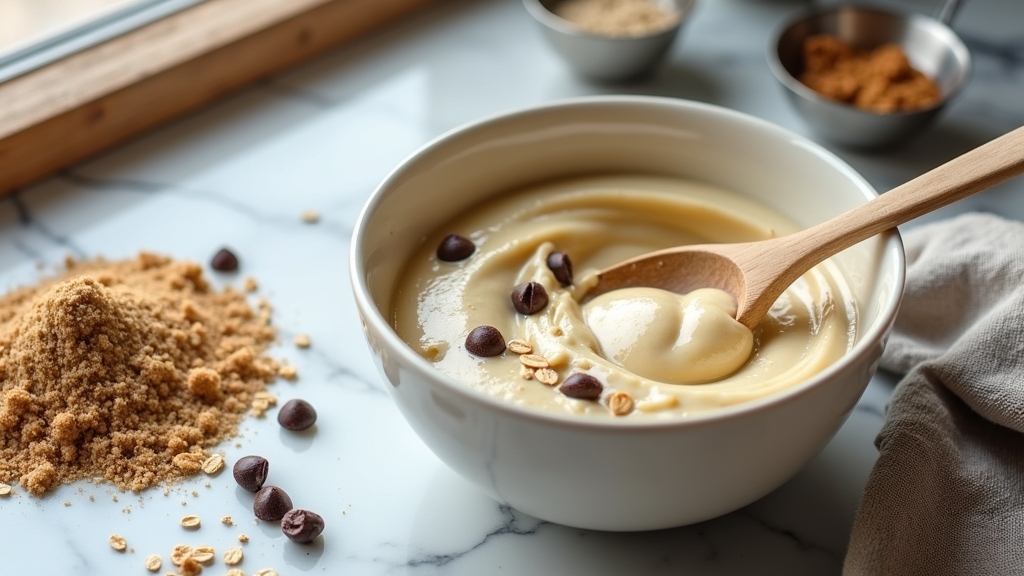
Measuring your dry ingredients precisely ensures the flour, leaveners, and salt give predictable structure and even rise. The long shelf life of some commercial mixes can affect ingredient performance, so be mindful of product age when baking with sourdough-based mixes.
Combine the wet ingredients thoroughly — melted or browned butter, sugars, discard, yolks, and vanilla — until the mixture is glossy and homogenous. Use a baking scale for the most consistent results.
Then gently fold the wet into the dry by hand until the dough is thick and slightly tacky.
Stop as soon as streaks disappear to avoid tough cookies.
Measure Dry Ingredients Precisely
Why does a few grams make or break your sourdough discard cookies? Because precision shapes texture, aroma and spread: a scale’s tiny click can mean tender chew or tough bite. You’ll weigh all-purpose flour, leaveners and salt in grams, noting that 95–340 g flour ranges with batch size.
Whisk or sift baking soda and powder to distribute lift evenly; expired leavening steals rise. Match salt type to volume—Diamond Crystal differs from Morton’s—so flavor stays balanced. Measure fresh, avoid packed cups, and keep flours at room temperature to prevent clumping.
As you slowly add dry to wet, controlled amounts limit gluten development so the cookies stay soft, not dense, and the discard’s moisture integrates predictably. Browning butter concentrates flavor and reduces water, so account for that change when balancing liquids with brown butter.
Bakers often choose a pre-ferment to boost flavor and extensibility in baked goods, and poolish or sourdough starter both affect hydration and taste.
Combine Wet Ingredients Thoroughly
When you whisk melted butter, sugars, sourdough discard, eggs and vanilla until glossy and smooth, you’ll feel the mixture loosen and smell the caramel notes from the sugars melding with the starter’s tang — indicators that everything’s evenly dispersed and ready to meet the dry ingredients.
Work with room-temperature eggs and discard, and cooled melted butter, so the emulsion forms without curdling.
Whisk or use a hand mixer just until brown sugar dissolves and no streaks remain; that sheen means fats and sugars are integrated and moisture is controlled.
Properly combined wet ingredients prevent grainy pockets, uneven acidity, and inconsistent baking.
- Whisk until glossy, no sugar granules remain.
- Keep ingredients similarly tempered.
- Avoid over-aeration.
- Adjust discard hydration as needed.
Keeping your starter in cold storage between bakes will reduce how often you need to feed it and help maintain a predictable discard hydration. Also consider timing your mixing to align with your bulk fermentation schedule to make the most of your starter’s activity.
Gently Fold Wet Into Dry
Start by pouring the dry ingredients into the glossy wet mixture in a slow, steady stream, then fold with a flexible spatula using gentle, sweeping motions so you barely see streaks of flour — you’ll feel the batter thicken and warm butter and sourdough aromas mingle as pockets of flour disappear.
Using a snug, waterproof cover like a shower cap can help maintain the dough’s hydration during resting periods for optimal results moisture retention. You’ll rotate the bowl with one hand and fold in a circular, figure-eight motion, stopping when no large dry patches remain but a few small specks persist.
That restrained motion limits gluten, keeps the dough tender and slightly lumpy, and lets the discard’s acidity and moisture spread evenly.
Don’t stir or beat; save some flour pockets for mix-ins. Expect a sticky, hydrated dough that chills into the perfect chewy-tender cookie texture.
Using browned butter adds a deeper, toasty flavor that complements the discard and chocolate, and it’s a hallmark of this recipe’s rich profile browned butter.
Adding Mix-Ins and Flavorings
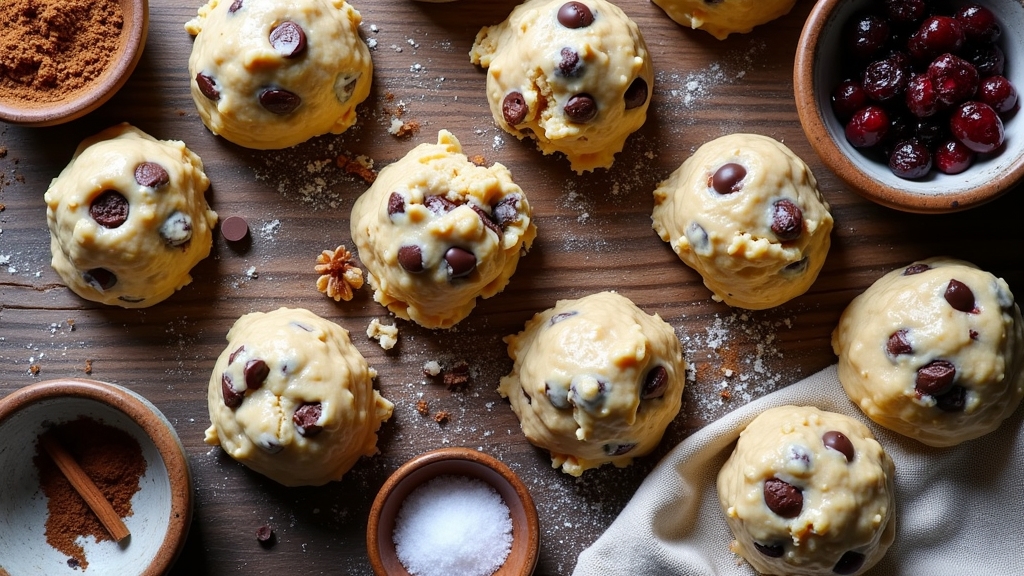
Now you’ll choose the extras that make these sourdough discard cookies sing: gooey chocolate chip variations from bittersweet chunks to milk chips, crunchy nuts and seeds like toasted pecans or sunflower seeds for contrast, and aromatic extracts and spices to round everything out.
Taste the interplay of tangy discard with brown butter, vanilla, cinnamon or orange zest as you mix — bold mix-ins stand up best to stronger sour notes.
For even flavor distribution, fold chips and chopped nuts gently into the dough and add extracts to the wet ingredients so each bite is balanced and textured.
Using sourdough discard not only adds flavor but also aids digestion, improving the cookies’ complexity and nutritional benefits.
Chocolate Chip Variations
Want cookies that sing with melty pockets of chocolate and a hint of tang? You’ll dial texture and flavor by choosing chocolate type, chunk size, and complementary enhancers.
Milk, semisweet, or dark chips shift sweetness and intensity; larger chunks create molten puddles, while even distribution guarantees gooey bites without cakiness. Balance butter and chocolate to tune softness and chew. Try brown butter for nutty caramel notes, stir in vanilla for warmth, and mix brown plus white sugar to boost chew and caramelization.
Sprinkle flaky salt atop warm cookies to elevate contrast. Chill or bake immediately depending on desired spread; refrigerated discard deepens flavor.
Use up to 1.5 cups of chips for generous chocolate throughout. For consistently even mixing when scaling up this recipe or working with thick doughs, consider a stand mixer with a powerful motor and adequate bowl capacity to handle larger batches.
Nut and Seed Additions
Looking to add crunch and depth to your sourdough discard cookies? Toast chopped walnuts, pecans, almonds, macadamia, or hazelnuts first to awaken their aroma and buttery notes, then fold them in so each bite offers crisp contrast to tender crumb. For best results, use a kitchen scale to weigh your mix-ins for consistent texture and balance across batches.
Sprinkle in seeds—chia, flax, pumpkin, sunflower, sesame, or hemp hearts—for earthy, nutty undertones and visual interest.
Aim for about 100 grams total per batch, combining roughly chopped nuts with smaller seeds to balance bite size and texture without breaking dough cohesion.
Add mix-ins last to preserve crunch, and remember they absorb moisture, so adjust binding if needed.
Store finished cookies airtight to keep oils from turning and maintain that satisfying, toasty crunch.
You can also experiment with different ratios to suit allergies or flavor preferences, since nuts and seeds provide varying levels of oil and texture, making them an easy way to tweak the cookie’s nutrition profile.
Extracts and Spices
How do you want your sourdough discard cookies to smell and sing on the tongue? You’ll pull warmth from vanilla—2–3 teaspoons mixed with butter and sugar—to round the discard’s tang.
Cinnamon (½–1½ tsp) brings cozy aroma; ginger (¼–½ tsp) adds bright bite; nutmeg and cloves (⅛–¼ tsp) deepen the profile. Mix spices with dry ingredients and extracts with wet, then chill to meld.
- Vanilla for balance and warmth
- Cinnamon for nostalgic, aromatic depth
- Ginger/nutmeg/cloves for spice complexity
- Honey, brown sugar, or chocolate chips for sweetness and texture
Finish with a sprinkle of flaky sea salt and bake gently so the spice bouquet stays vivid and the center stays tender. Chilling the dough for at least 30 minutes before baking helps prevent the cookies from spreading too much and preserves the intended texture chill period.
Shaping, Chilling and Baking
Curious how to get bakery-style edges and even baking from gooey sourdough-discard dough? Handle the wet, buttery dough gently so it stays tender: fold in chocolate chunks with a spatula to distribute mix-ins without overworking. Freezing portioned dough can improve convenience and promote resistant starch formation that benefits texture and glycemic response.
Scoop uniform portions with a cookie scoop or spoon, then gently flatten each mound for crinkled edges — a light tap of the baking sheet helps the texture form.
Chill the portioned dough at least 30 minutes, or overnight, to firm fats and meld flavors; refrigerated discard contributes extra chill and eases shaping.
Bake on a preheated tray at 350–375°F (177–190°C) for roughly 10–14 minutes, watching for browned edges and soft centers. Let cookies rest briefly on the sheet, then transfer to racks to cool completely. Added to this, ensure your butter is soft but cool so the dough traps air for a chewy texture soft but cool butter.
Troubleshooting Texture and Spread
You’ve set and chilled the dough for clean edges and even baking; now focus on why cookies sometimes spread like pancakes or stay stubbornly puffy. You’ll notice texture shifts in the first bite: too-flat cookies feel greasy, too-puffy ones taste cakey. Tastes and feel trace back to moisture, flour, starter hydration, mixing, and bake timing.
- Balance moisture: reduce discard or use browned butter and omit whites to cut water, or add a touch more flour to tighten dough. This is especially important because sourdough discard works well in quick breads, pancakes, muffins, etc. A slightly stiffer dough mimics the effect of a lower hydration starter and helps control spread.
- Measure flour by weight: prevent under- or over-flouring that causes runaway spread or dry cakiness.
- Adjust starter hydration: stiffer starter yields less spread; a too-wet starter makes thin cookies.
- Mix and chill gently: avoid overworking, then chill to firm dough so cookies bake with chew, not puddles.
Storage and Serving Suggestions
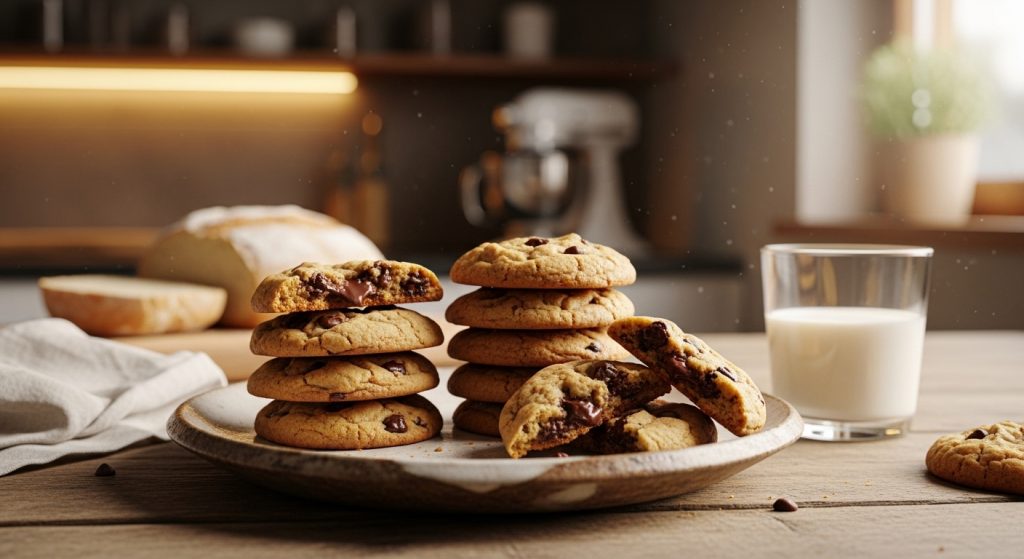
Want those sourdough discard cookies to taste as fresh as the moment they came out of the oven? Store baked cookies in airtight containers at room temperature for 4–7 days—chewiness will deepen and crisp edges will soften pleasantly.
Toss in a small piece of white bread to preserve moisture, and avoid loosely covered boxes that let cookies dry out. For short-term serving, leave a plate out but eat within a day for best texture. Freeze individually wrapped cookies in freezer-safe bags for up to 3 months; thaw at room temperature or reheat briefly to revive texture.
Keep unbaked dough refrigerated up to 7 days or freeze portioned dough balls 2–4 months, labeling dates. Serve slightly warm, with milk, coffee, or tea. Browned butter adds a richer, nuttier flavor and helps create a chewier texture when used in these cookies brown butter.
For best results, store the cookies on a cloth-lined tray or in a bowl dusted with a little flour to avoid sticking and promote gentle airflow, similar to using a linen-lined bowl for proofing.
Frequently Asked Questions
Can I Use Whole Wheat or Gluten-Free Flour Instead of All-Purpose?
You can use whole wheat or gluten-free flour instead of all-purpose. You’ll notice a nuttier, earthier aroma and a denser, chewier bite with whole wheat; add a touch more fat or sugar and slightly more liquid to soften it.
With gluten-free blends, expect crumblier texture and variable flavors; use a baking blend and add a binder like xanthan gum, adjusting hydration to keep cookies tender and cohesive.
Can I Freeze Baked Cookies for Longer Storage?
Yes — you can freeze baked cookies for longer storage, and they’ll keep best for 2–3 months.
Let them cool completely, flash-freeze on a tray until firm, then layer with parchment and seal airtight to avoid freezer burn. Label with date.
Thaw at room temperature or warm briefly in a low oven to revive crispness.
Avoid freezing delicate icings or fillings; add those after thawing for best texture and flavor.
Will Sourdough Discard Cookies Be Vegan-Friendly?
Yes, they can be vegan-friendly. Think of the discard as a forest stream: pure, plant-fed, tangy water that nourishes dough.
You’ll smell coconut oil or vegan butter, taste brown sugar and dark chocolate, and feel chewy, tangy crumbs.
Keep dairy, eggs, and non-vegan chocolate out, check sugars and cross-contamination, and use vegan substitutes.
Do that, and your sourdough discard cookies stay fully plant-based and delicious.
How Do I Scale the Recipe for Larger Batches?
Scale it linearly by weight, using a digital scale so ingredients multiply evenly and textures stay consistent. You’ll notice dough feels denser as volume grows, so keep ratios—flour to discard, sugar, butter—steady.
Use bigger bowls or a stand mixer, chill longer, and divide dough for manageable mixing.
Bake in multiple trays at the same temperature, rotating midway, and slightly adjust baking time as needed for even browning and firm centers.
Can I Substitute Coconut Oil for Butter?
You can substitute coconut oil for butter, but expect changes: your cookies will be slightly denser, softer, and a bit crumblier, with less buttery richness.
Use about ¾–1:1 ratio (¾ cup coconut oil per 1 cup butter for a firmer result), prefer refined for a neutral taste, unrefined for coconut notes. Reduce other liquids slightly to offset lost steam, and chill dough if you want crisper edges and better shape.
Share, Store and Savor Every Cookie Bite
You’ve turned simple sourdough discard into warm, buttery cookies that smell like a bakery and taste like comfort. As you bite, the crisp edge gives way to a tender, slightly tangy crumb, studded with whatever mix-ins you chose—chocolate, nuts, or citrus zest—each note singing.
Keep them chilled before baking to control spread, and store airtight to preserve texture. Serve slightly warm with tea or—anachronistically—a Victorian teacup for a charming touch.

